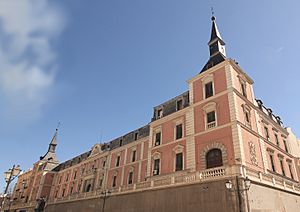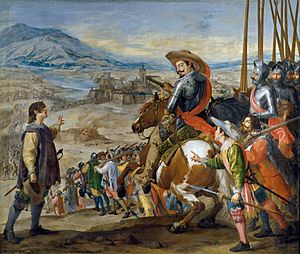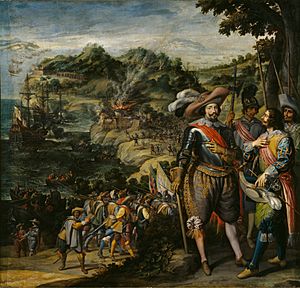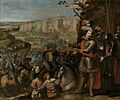Hall of Realms facts for kids
The Salón de Reinos means "Hall of the Kingdoms" or "Hall of Realms." It's also known as the salón grande or "great hall." This important building from the 1600s is in Madrid, Spain. It was originally a part of the huge Buen Retiro Palace. Today, the Salón de Reinos and the Casón del Buen Retiro are the only parts of that grand palace still standing.
The Hall of Realms was built between 1630 and 1635. It was designed to hold the biggest paintings from the royal art collection. These famous artworks are now kept at the Museo del Prado. The hall got its name because it featured paintings of the coats of arms from the 24 kingdoms that made up Spain during the time of Philip IV of Spain.
For many years, from 1841 to 2010, the building was home to the Museo del Ejército (Army Museum). Later, the military collections were moved to the Alcázar of Toledo. The Prado Museum then bought the empty building. They wanted to use it to show more of their art. In 2016, a design competition was held to decide how to update the building. The winning design came from a British company called Foster and Partners and a Spanish company called Rubio Arquitectura. Their plan is to make the Salón de Reinos part of the Prado Museum's main campus.
Contents
What is the Salón de Reinos?
The Salón de Reinos was first planned as a place where the king could watch plays in the palace courtyard. But then, the Buen Retiro was made into a full palace. So, the Salón de Reinos became a special throne room. It was still used for parties and shows, so a balcony was added for people to watch from above.
As a throne room, it had to look very impressive. Important visitors, like ambassadors from other countries, would come to the palace. The room's decorations were the most amazing in the whole palace. It had many windows that let in lots of light. There were also fancy tables made of jasper stone and silver lions. The ceiling was covered in interesting designs called grotesques.
The walls were covered with paintings that had a secret meaning. They were all about making King Philip IV look powerful and great. We don't know exactly who designed all the decorations. But the main person in charge was the Conde-Duque de Olivares, who was a very important advisor to the king. Other people who helped were Jerónimo de Villanueva, Francisco de Rioja, and famous painters like Juan Bautista Maíno and Velázquez.
Famous Paintings in the Hall
The Salón de Reinos is shaped like a rectangle. It has narrow doors on its two longer sides. The walls were covered with incredible art.
On the north and south walls, there were twelve large paintings. These paintings showed the most important battles won by Philip IV's armies early in his reign. One of these paintings is now lost. Between these battle paintings, above the windows, were ten paintings by Zurbarán. These showed the labours of Hercules. Hercules was a mythical hero, and the paintings compared his great deeds to those of the king. People at the time believed Hercules was an ancestor of the House of Habsburg, the royal family.
The battle paintings were made by different artists. Some were older, like Vicente Carducho and Eugenio Cajés. They had worked for the previous king, Philip III of Spain. Other artists were younger and painted in a more realistic style. These included Juan Bautista Maíno, Zurbarán (who came all the way from Seville for this job), Jusepe Leonardo, Félix Castelo, Antonio de Pereda, and especially Velázquez, who was King Philip IV's favorite painter.
At the east and west ends of the hall, there were portraits of the royal family painted by Velázquez. On the west wall, there were equestrian portraits (paintings of people on horseback) of Philip III and his wife Margaret of Austria. On the east wall, there were equestrian portraits of Philip IV and his wife Elisabeth of France. Between them was a portrait of their son and future king, Balthasar Charles. These five paintings were placed in a special way to show how the monarchy was passed down through the family, from one generation to the next.
The hall also displayed shields with the coats of arms of the twenty-four kingdoms and realms that Philip IV ruled. These included places like Aragon, Castile and León, Principality of Catalonia, Portugal, Naples, and Mexico.
West Wall (Main Entrance)
Three famous paintings by Velázquez:
- Equestrian Portrait of Philip IV
- Equestrian Portrait of Elisabeth of France
- Equestrian Portrait of Prince Balthasar Charles
East Wall (Behind the Throne)
- Equestrian Portrait of Philip III, by Velázquez and his workshop
- Equestrian Portrait of Margarita of Austria, by Velázquez
North Wall
- The expulsion of the Dutchmen from the island of San Martin by the Marquis of Cadreita, by Francisco de Zurbarán (this painting is now lost).
- The capture of Rheinfelden by Vicente Carducho. This large oil painting is at the Museo Nacional del Prado.
- The Relief of Brisach by Jusepe Leonardo. This oil painting is also at the Museo Nacional del Prado.
- The relief of the Plaza de Constanza, by Vicente Carducho. Another oil painting at the Museo Nacional del Prado.
- The recovery of the island of Puerto Rico by Don Juan de Haro, by Eugenio Cajés. An oil painting at the Museo Nacional del Prado.
- The recovery of the island of San Cristobal by Don Frederic of Toledo, by Felix Castelo. An oil painting at the Museo Nacional del Prado.
South Wall
- The Recovery of Bahia by Juan Bautista Maíno. An oil painting at the Museo Nacional del Prado.
- The Relief of Genoa by the second Marquis of Santa Cruz, by Antonio de Pereda y Salgado. An oil painting at the Museo Nacional del Prado.
- The victory at Fleurus, by Vicente Carducho. An oil painting at the Museo Nacional del Prado.
- The surrender of Juliers by Jusepe Leonardo. An oil painting at the Museo Nacional del Prado.
- The Surrender of Breda, by Diego Velázquez. This famous oil painting is at the Museo Nacional del Prado.
- The defense of Cadiz against the English, by Zurbarán. An oil painting at the Museo Nacional del Prado.
Trials of Hercules Paintings
Above the windows, there were ten paintings showing the trials of Hercules by Zurbarán. All of these oil paintings are now at the Prado Museum. They include:
- Hercules and the Cretan bull.
- Hercules's struggle with Antaeus.
- Hercules' struggle with the Erymanthian boar.
- Hercules diverting the river Alpheus.
- Hercules and Cerberus.
- Hercules wrestling with the Nemean lion.
- Hercules fights the Hydra of Lerna.
- Hercules closes the straits of Gibraltar.
- Hercules kills king Gerion.
- Death of Hercules.
Later History of the Hall
The Salón de Reinos and the Salón de Fiestas (which is now the Casón del Buen Retiro) were the only parts of the palace that survived a heavy French attack between 1808 and 1814. This happened during the Peninsular War. After the war, the buildings were rebuilt and looked different.
For a long time, starting in 1841, the Salón de Reinos was home to the Museo del Ejército, the Army Museum.
Restoration Plans
In the early 2000s, the Spanish Ministry of Culture started plans to move the Army Museum. They wanted to give the Hall of Realms to the Prado Museum. The Prado Museum already looked after the Casón del Buen Retiro. The idea was to make the Salón de Reinos look like it did in the 1600s again. This was possible because the wall paintings, ceiling paintings, and grotesques were still in good condition.
However, this idea caused some debate. Some people didn't like it because it would move famous paintings like Velázquez's The Surrender of Breda away from his other works in the Prado. Others felt it wasn't necessary to recreate just one room.
A competition was held to redesign the building. In 2017, plans from the winning design were shown in an exhibition. The winning team, Foster and Rubio, planned to remove some of the changes made after the 17th century. They also wanted to add modern features.
The work to restore the building has been delayed many times. The Army Museum reopened in Toledo in July 2010. The work on the Salón de Reinos was first expected to happen from 2010 to 2012. But due to money problems, the project was put on hold until 2021.
While waiting for the building work to start, the Salón de Reinos has been used for other things. For example, it has hosted temporary art shows. In 2017, the artist Cai Guo-Qiang used the Hall of Realms to create 8 artworks using gunpowder.
Images for kids
-
The capture of Rheinfelden by Vicente Carducho.
See also
 In Spanish: Salón de Reinos para niños
In Spanish: Salón de Reinos para niños








